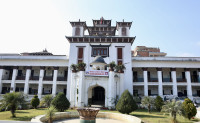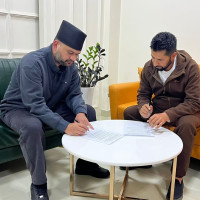Politics
Politics becomes more complicated in ways that will exacerbate gridlock
Oli refuses to budge as the Dahal-Nepal faction explores options, only to find none as of now.
Tika R Pradhan
Days after the Supreme Court overturned Prime Minister KP Sharma Oli’s House dissolution move, calling it unconstitutional, Oli on Sunday said that he would not resign and challenged his opponents to unseat him.
“You have reinstated the House by winning the case. Now remove me. Get a no-confidence motion endorsed,” said Oli at a function in Jhapa district on Sunday.
Oli was referring to Pushpa Kamal Dahal and Madhav Kumar Nepal, who have fallen out with him.
The Supreme Court on February 16 sent Nepali politics back to Parliament by asking authorities to call a House meeting within 13 days. The government has accordingly recommended the winter session of the federal parliament to commence on March 7.
Since Oli has not resigned, which, in principle, he should have done on moral grounds, the Dahal-Nepal faction is now in a fix.
And politics has become more complicated than ever before.
There is no legal or constitutional way to oust Oli, which the Dahal-Nepal faction wants, unless there is a new equation in Parliament. And that’s not possible if the Nepali Congress chooses to stay quiet.
The current composition of the House goes thus: The Dahal-Nepal faction controls around 90 seats, the Oli faction has 80 to 83, the Nepali Congress 63 (two suspended) and the Janata Samajbadi Party 34 (two suspended). Rastriya Prajatantra Party, Nepal Majdoor Kisan Party and Rastriya Janamorcha have one seat each. There is one independent lawmaker.
“The only option we have is to force Oli to resign, but if he refuses to do so, we will oust him through a no-confidence motion,” said Barsaman Pun, a Standing Committee member of the Dahal-Nepal faction. “We are confident that the Nepali Congress will support us when the House session begins.”
The Congress, however, has decided to play safe and has not expressed its commitment to the Dahal-Nepal faction’s request for support. The Nepali Congress has been in a wait-and-see mode, saying the Nepal Communist Party has not split yet, legally.
The Election Commission so far has refused to take any decision on the Nepal Communist Party. Even though the Nepal Communist Party had filed an application at the Election Commission saying that a majority of the 441 Central Committee members are with it, the poll body continues to recognise Oli and Dahal as party chairs.
In the poll body’s eyes, there is just one Nepal Communist Party which was registered with it in May 2018.
Unless there is a decision by the Election Commission, the House too recognises just the Nepal Communist Party, not the factions led by Oli or Dahal and Nepal.
One way to remove Oli as prime minister could be the Dahal-Nepal faction making a move by showing that the majority of lawmakers are on its side, according to observers.
Hari Roka, a political economist, said if the Dahal-Nepal faction has a majority of lawmakers on its side, it should get Oli removed as the leader of the Parliamentary Party first.
“The best legal option the Dahal-Nepal faction can pursue is to call a meeting of the Parliamentary Party with 25 percent of lawmakers,” said Roka.
For that, around 43 lawmakers of the Dahal-Nepal faction should make such a move. But there are still complications.
On December 22, two days after the House was dissolved, the Dahal-Nepal faction held a meeting of its Central Committee and decided to oust Oli as a member of the party. The faction also elected Dahal as the leader of the Parliamentary Party and apprised the Election Commission as well of the decision. But the House does not recognise these decisions. For the Dahal-Nepal faction to remove Oli as the leader of the Parliamentary Party, it first needs to roll back its December 22 decision of ousting Oli as a general member of the party and electing Dahal as the leader of the Parliamentary Party.
Pun admitted that a lot depends on the Election Commission.
But that’s a long shot. Before the House meeting commences, the Supreme Court is set to deliver a verdict on a three-year-old case regarding the “Nepal Communist Party” name.
The Nepal Communist Party was registered with the Election Commission under the name of Rishiram Kattel. Kattel moved the Supreme Court in December 2018 after the Election Commission agreed to register the Oli-Dahal-led Nepal Communist Party as “Nepal Communist Party (NCP)” with the NCP within brackets.
If the court gives the verdict in favour of Kattel, it could mean Nepal Communist Party (NCP), over which the Oli and Dahal-Nepal factions are squabbling, null and void, thereby taking it back to the pre-merger state when there was the UML and the Maoist Centre.
As of now, the Dahal-Nepal faction appears to be out of options.
Constitutional experts say things could be clearer once the House commences. According to them, Oli had formed the government under Article 76(1) but since his House dissolution move has been overturned and there are clearly two factions in the Nepal Communist Party, a new process could be started.
“Overturning of the decision of the government formed under Article 76(1) means such a government has already faced a defeat,” said senior advocate Chandra Kanta Gyawali, a constitutional expert. “There is not even the need for a no-confidence motion against Oli now and any lawmaker with claims of 138 members on his or her side can directly go to the President, seeking to form a new government under Article 76(2).”
Article 76 (2) says in case where no party has a clear majority in the House of Representatives under clause (1), the President shall appoint as prime minister a member of the House of Representatives who can command a majority with the support of two or more parties representing the House of Representatives.
“To claim a government formation under Article 76(2), a lawmaker does not even need to be the leader of the Parliamentary Party.”
But a lawmaker elected prime minister under Article 76 (2) must win a vote of confidence in the House within 30 days. For this, the Dahal-Nepal faction and the Nepali Congress must come together.
A lot now depends on the Congress party, according to Bipin Adhikari, former dean of Kathmandu University School of Law.
“The Congress party has to decide whether it wants to become ‘king’ or ‘kingmaker’,” Adhikari told the Post. “It can play a crucial role in government formation. Because of it, an election can be a compulsion. For stability and rule of law, giving the best way out should be the party’s objective.”
Political complexities, however, have occurred largely because of Oli’s refusal to step down despite losing political legitimacy.
The general understanding of the Dahal-Nepal faction was that Oli would resign on moral grounds once the House was restored.
“Resignation on moral grounds applies only to those who have the moral principle,” said Roka, the political economist and writer. “Yes, in principle, Oli should have stepped down and cleared the way for someone else to become prime minister after the House was reinstated.”
Now that Oli is refusing to resign, unless the Dahal-Nepal faction makes some moves, which no one knows what those could be, he is likely to continue as prime minister.
According to Gyawali, this situation of confusion arises also because of the Dahal-Nepal faction’s weaknesses as well as the Election Commission’s delay in deciding on the Nepal Communist Party legitimacy dispute.
According to analysts, if the Nepali Congress and Janata Samajbadi Party refuse to join hands with the Dahal-Nepal faction, Oli is likely to continue until a new situation emerges while either passing the bills or the budget.
“Since this government is a caretaker one, it is as good as a government that has already resigned and therefore Oli does not even have to resign,” said Adhikari. “The question now is how the president addresses the situation.”




 16.12°C Kathmandu
16.12°C Kathmandu













%20(1).jpg&w=300&height=200)

